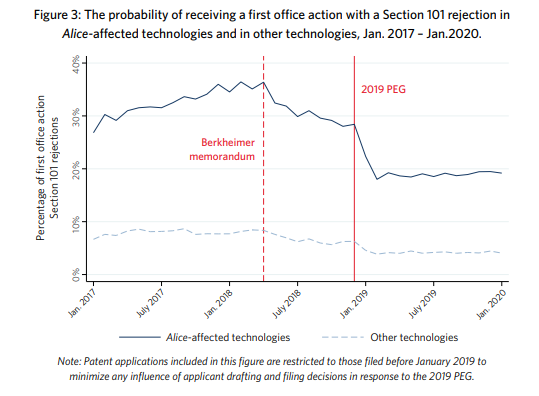By Brad Van Pelt
Data from the chief economist at United States Patent and Trademark Office (USPTO) indicates that examiners are rejecting fewer cases as being ineligible for patenting. A recent report issued by the chief economist’s office highlights this trend, and other USPTO patent examination outcomes, following the U.S. Supreme Court’s 2014 decision in Alice Corp. v. CLS Bank International.
Key findings from the report include:
- § 101
rejections in first office actions in Alice-affected
technologies:
- Increased by 31%, 18 months after Alice, but
- Decreased by 25%, 12 months after USPTO’s January 2019 Revised Patent Subject Matter Eligibility Guidance (2019 PEG).
- Variability across examiners in § 101
determinations in Alice-affected
technologies:
- Increased by 26%, 18 months after Alice, but
- Decreased by 44%, 12 months after the 2019 PEG.
In June of 2014, the Supreme Court in Alice Corp. v. CLS Bank International significantly altered the law on patent eligibility. The Court reviewed whether patent claims directed to a computer-implemented financial settlement system were eligible for patenting. The Court held claims patent ineligible, reasoning generic computer implementation does not transform a patent-ineligible abstract idea into a patent-eligible invention. Alice Corp. v. CLS Bank International, 573 U.S. 208 (2014). The Supreme Court’s decision significantly broadened the scope of ineligible subject matter and lead to much ambiguity into how the decision would be applied to technology involving “abstract ideas.”
In the 18 months following the Alice decision, the probability of receiving a rejection for patent-ineligible subject matter increased by 31%. But the data in the report shows that after the issuance of examination guidance documents in April of 2018 and January of 2019, the probability of receiving an eligibility rejection decreased. The USPTO typically prepares examination guidance documents in order to adjust to major changes in the U.S. patent law. Such documents are designed to assist examiners in applying the law during examination.
Figure 3 from the report, which is reproduced below, illustrates the trends in receiving a first office action containing patent ineligibility rejections for patent applications in Alice-affected technologies, and in other technologies, from 2017 through 2019. The first vertical bar (dashed red line) marks the date of the April 2018 Berkheimer memorandum and the second vertical bar (solid red line) marks the date of the 2019 PEG.
This report is helpful to applicants in deciding whether to file for patent protection on Alice-affected cases, including various forms of software. For now, applicants have much needed clarity in outcomes in front of the USPTO and less chance of receiving ineligible subject matter rejections from the USPTO. But the USPTO’s determinations and guidance are not binding on the Federal Circuit or the Supreme Court.

Posted: April 30, 2020


